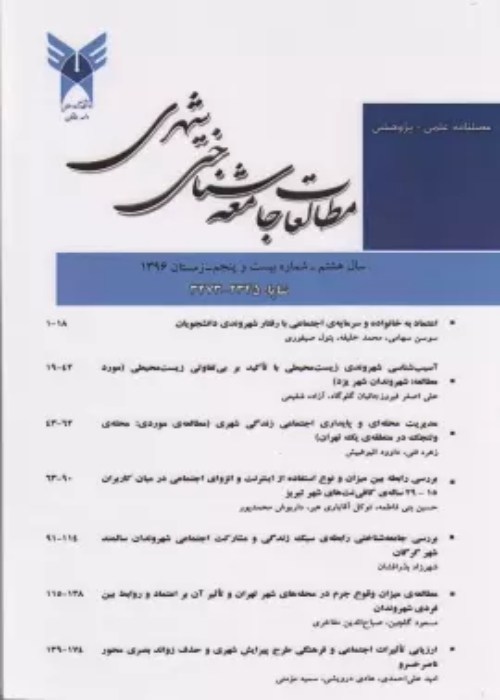Studying Deviance Differentials between Modern and Old Sections of the City (case of study: the city of Hamadan)
Author(s):
Abstract:
Most parts of the big cities in Iran are dilapidated and cannot afford their residents with suitable facilities. As a result, the middle and upper classes move to newly-built parts and districts with modern texture and planning. The old parts have become a kind of heaven for crimes due to buildings with no owners, lack of proper lighting, and lack of modern technologies and facilities like closed-circuit cameras and availability of quiet corners. In this study using crime prevention through environmental design (CPTED) theory, two parts of the modern and old sections in Hamadan have been analyzed. The main purpose of this study is to analyze the differences between social abnormalities in modern and traditional parts of Hamadan city and the role of environmental planning in it between 1391 to 1392. This research is a survey one that uses the causal analytical method. The research population consisted of all the residents of the city of Hamadan that was divided into two parts: modern and traditional. The residents of the modern subgroup live in four neighborhoods: professors` district, specialists` district, Saeidiye district and Pardis district and the traditional parts were limited to Joulan, Emamazadeh Yahya, Babataher street, Ekbatan and Shohada street. This population comprised 418000 people of which 75000 resided in modern districts and 343000 in traditional parts. Sample size was estimated to be 384 using Cochran formula. Samples were selected by quota and simple random sampling. The data were gathered by applying two researcher-made questionnaires and were analyzed by SPSS using MANOVA. Face and content validity as well as factor analysis and reliability estimates was assessed by Cronbach's alpha coefficient which was greater than 0.70 in all dimensions. The results according to CPTED theory indicated that there is a relationship between abnormalities in old and modern parts of Hamadan and environmental planning is effective in this regard in a way that planning the city environment in general (F=7.176, P=0.008) and its five dimensions of scoping (domain-oriented) (F=4.121, P=0.017), Monitoring (surveillance) (F=4.51, P=0.012), Access Control (input) (F=4.795, P=0.009), Image and space storing (F=10.323, P=0.001), Making it hard to commit crimes (F=4.388, P=0.013), support activities (supporting) (F=3.287, P=0.038) in both modern and traditional parts affect crime and deviant behaviors differently.
Keywords:
Language:
Persian
Published:
Urban Sociological Studies, Volume:4 Issue: 11, 2014
Page:
181
magiran.com/p1327983
دانلود و مطالعه متن این مقاله با یکی از روشهای زیر امکان پذیر است:
اشتراک شخصی
با عضویت و پرداخت آنلاین حق اشتراک یکساله به مبلغ 1,390,000ريال میتوانید 70 عنوان مطلب دانلود کنید!
اشتراک سازمانی
به کتابخانه دانشگاه یا محل کار خود پیشنهاد کنید تا اشتراک سازمانی این پایگاه را برای دسترسی نامحدود همه کاربران به متن مطالب تهیه نمایند!
توجه!
- حق عضویت دریافتی صرف حمایت از نشریات عضو و نگهداری، تکمیل و توسعه مگیران میشود.
- پرداخت حق اشتراک و دانلود مقالات اجازه بازنشر آن در سایر رسانههای چاپی و دیجیتال را به کاربر نمیدهد.
In order to view content subscription is required
Personal subscription
Subscribe magiran.com for 70 € euros via PayPal and download 70 articles during a year.
Organization subscription
Please contact us to subscribe your university or library for unlimited access!


